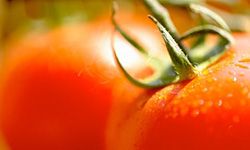
Wander the produce aisle at your local grocery store and you'll find a dazzling variety of tomatoes, from cherry to grape to pear-shaped to massive beefsteaks and gnarly heirlooms. Same with squash, potatoes, cucumbers and leafy greens. This bounty of diverse colors, shapes and sizes isn't the result of natural selection, but rather human selection.
Over millennia, farmers and plant breeders have spotted useful mutations in fruits and vegetables — tastier fruit, better yields, novel shapes — and preserved those traits through conventional breeding techniques. The process is slow, but if you cross different strains enough times, eventually you may create something new enough and marketable enough to be called its own variety.
Advertisement
That slow-and-steady conventional breeding process is about to get a big boost from advances in genetic mapping. With a tomato or cucumber genome in hand, plant breeders don't have to wait months for a tomato plant to bear fruit to know if the tomatoes will be pear-shaped or round. Instead, they can look for telltale markers in a seedling's DNA that code for specific fruit shape, size and color. This technique of "marker-assisted selection" promises to cut years off the traditional plant breeding process.
Esther van der Knaap is at the forefront of genetic research into exactly how a plant's DNA instructs its fruit to grow long and lean like a hothouse cucumber or round and squat like a beefsteak tomato. In her lab at the University of Georgia, postdocs and undergraduates slice tomatoes in half and place them on a flatbed scanner to measure the precise shapes and sizes produced by different genetic combinations.
In a paper published on Nov. 9, 2018 in the journal Nature Communications, van der Knaap announced the discovery of two families of genes that appear to play key roles in making fruits and vegetables either round or long. Fruits and vegetables are technically a plant's edible organs, and those organs grow and develop through cell division.
"To make a certain shape, like a long or a round shape, you need to have certain patterns of cell division," explains van der Knaap. "Either the cells divide horizontally or they divide vertically."
That makes sense. The more an organ's cells divide horizontally by splitting down the middle, the more they're going to build up tissue horizontally, creating a fatter, rounder fruit.
What van der Knaap and her colleagues discovered in the tomato genome is a specific gene called OVATE that appears to be responsible for creating proteins that tell cells to divide in a vertical pattern. When more cells split side to side, the growth pattern produces an elongated fruit. OVATE is the difference between a perfectly round cherry tomato and a pear-shaped tomato.
Wild tomatoes, like the native varieties found in Peru, Ecuador and Mexico, are invariably small and round, says van der Knaap, which means pear-shaped and other elongated tomatoes are mutations that came along later. As far back at the 1930s, plant biologists called the elongation mutation OVATE, but had no clue about the actual genetic mechanism behind it.
Now that van der Knaap has identified the OVATE protein, as well as another family of proteins called TRMs that interact with OVATE, it provides another tool to plant breeders who are using marker-assisted selection. If the OVATE and TRM markers are present, you can be sure the fruit will be elongated. If one or the other is missing, it's back to round. Van der Knaap says this will speed up the breeding process and let growers focus on trickier traits like yield and pest resistance that aren't as easily linked back to one or two genes.
So now the question is, do these advances in plant genetics mean that your produce aisle will soon include square tomatoes or pyramid-shaped pumpkins? Not likely, says van der Knaap, but not because it's technically impossible. She says there are tons of bizarre mutations in the tomato genome that result in crazy-looking fruits. And since those mutations are naturally occurring, they could be isolated and replicated in the lab.
But the problem with square tomatoes and other oddball-shaped fruit is two-fold, van der Knaap says. First, there's the GMO problem. If plant breeders use gene editing to directly tweak or replace genes in food plants, then those strains are considered GMO, and people get freaked out by GMOs in their food.
Second, brand-new fruit and vegetable shapes may simply taste nasty.
"Some mutations are so bizarre that no grower would grow them, because they have lots of other problems," says van der Knaap. "They only have a few fruit per plant or they taste terrible, because when you grow a fruit in a really odd shape, you mess up the hormone balance. It may not be very juicy and tasty at all."
If you really want to grow a square tomato, says van der Knaap, just put a box around it like the Japanese do with those crazy square watermelons. "That would be a high-end tomato," the researcher says. "I don't know if I'd want to pay for that."
Advertisement


